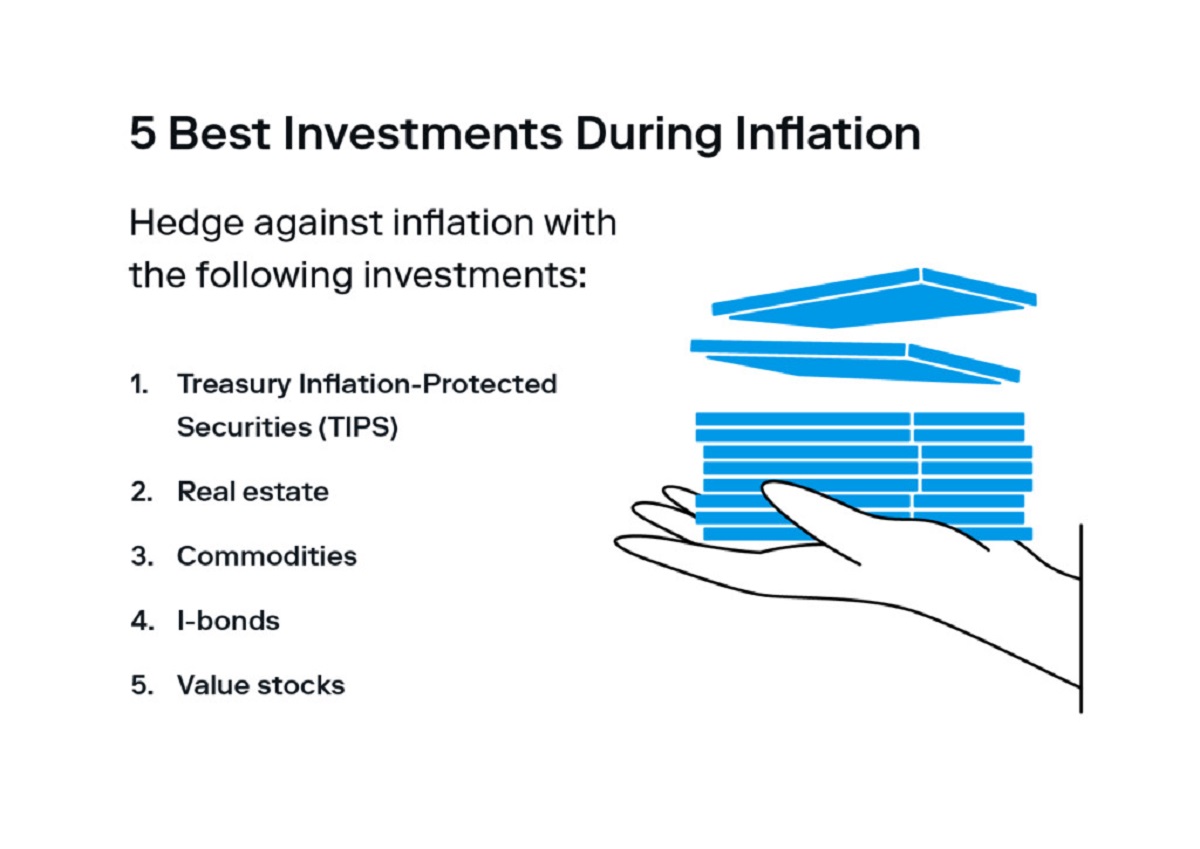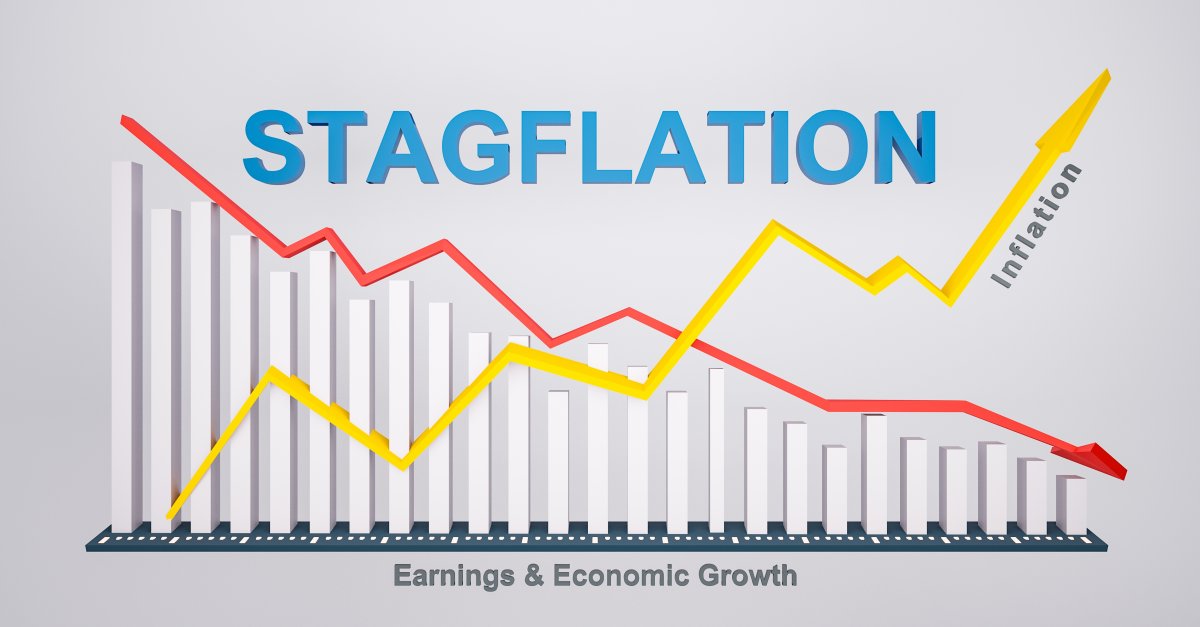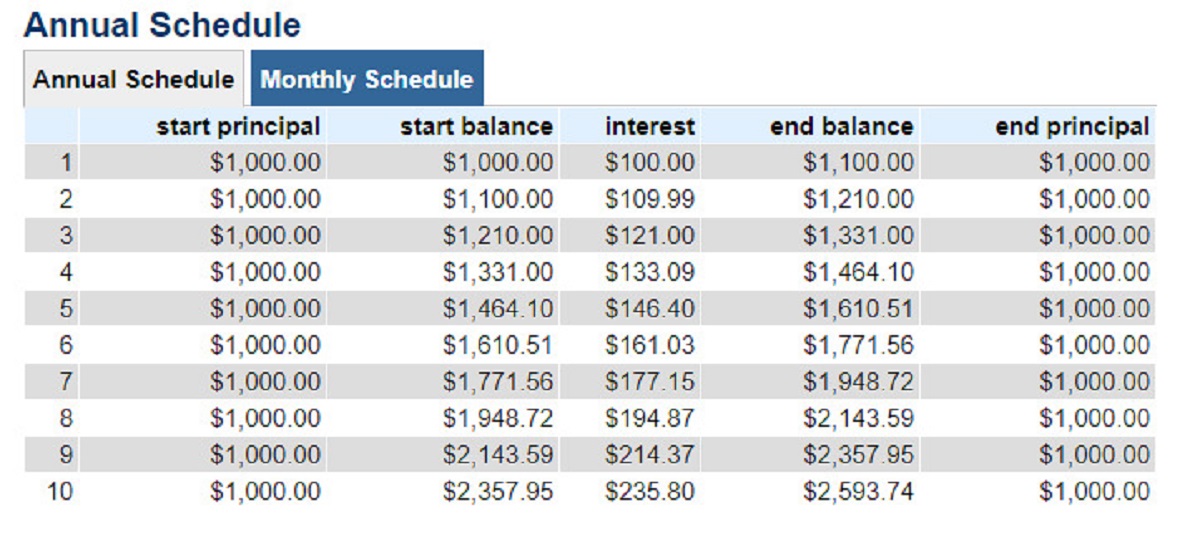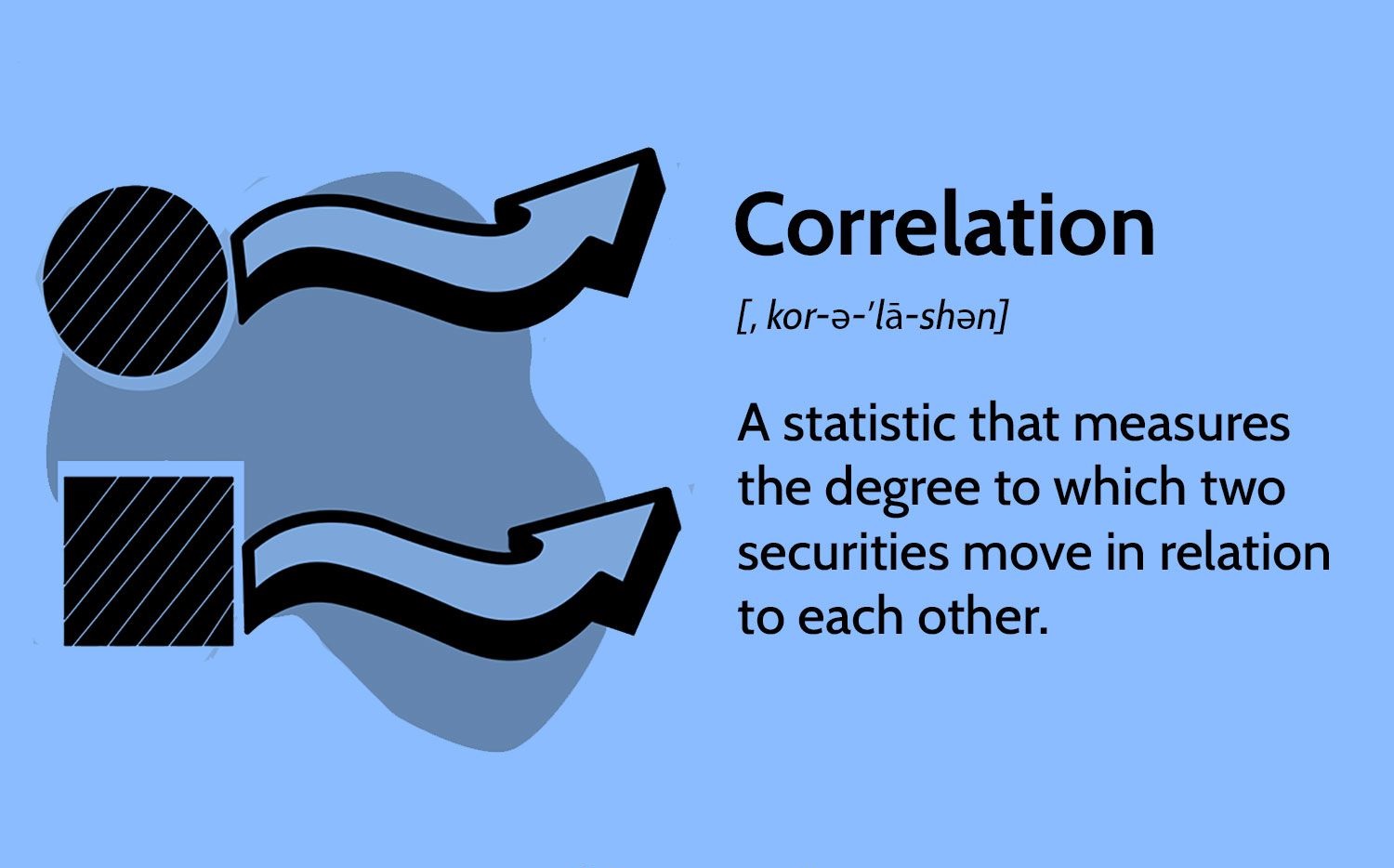Understanding Inflation
Before delving into the best investments during inflation, it’s essential to have a clear understanding of what inflation actually is. Put simply, inflation refers to the sustained increase in the general price level of goods and services in an economy over a period of time. This means that the purchasing power of a currency decreases, as it takes more money to buy the same goods and services.
Inflation is typically measured by the Consumer Price Index (CPI), which tracks the changes in the prices of a basket of commonly purchased goods and services. When inflation is high, it erodes the value of money and can have a significant impact on individuals and businesses alike.
There are several factors that contribute to inflation, including increased demand, rising production costs, changes in government policies, and fluctuations in the global economy. While a moderate level of inflation is considered a sign of a healthy economy, high or hyperinflation can have detrimental effects on consumer purchasing power, savings, and overall economic stability.
Inflation can have both positive and negative effects on investments. On one hand, certain investments can benefit from inflationary pressures, while on the other hand, others may suffer from decreased value. Understanding the relationship between inflation and investments is crucial for making informed decisions during times of rising prices.
During periods of inflation, investors often seek to protect their wealth by investing in assets that can either maintain their value or even appreciate. These investments are generally perceived as hedges against inflation, as they have the potential to outpace the rate of inflation and preserve purchasing power.
While no investment is entirely immune to inflation, some asset classes have historically performed well during inflationary periods. From real estate and stocks to commodities and inflation-protected securities, there are a variety of investment options available to investors looking to navigate the effects of inflation.
In the following sections, we will explore some of the best investments during inflation and discuss the benefits and considerations associated with each.
The Impact of Inflation on Investments
Inflation can have a significant impact on investments, affecting their real returns and purchasing power. Understanding how different asset classes are affected by inflation is crucial for investors looking to make informed decisions.
One of the primary ways that inflation affects investments is through the erosion of purchasing power. As the general price level increases, the same amount of money can buy fewer goods and services. This means that if investment returns do not outpace inflation, the real value of the investment will decrease over time.
This is particularly relevant for fixed-income investments such as bonds and certificates of deposit (CDs). These investments typically offer a fixed rate of return, which may not be able to keep up with inflation. As a result, the purchasing power of the interest income earned on these investments may be diminished.
However, not all investments are negatively impacted by inflation. Some asset classes have historically performed well during inflationary periods, allowing investors to maintain or even increase their purchasing power.
For example, real estate has often been seen as a favorable investment during inflationary periods. As the cost of living increases, so does the value of real estate properties. Investing in rental properties or real estate investment trusts (REITs) can provide a steady stream of income and potentially appreciate in value over time.
Stocks and equity funds have also shown resilience against inflation. While inflation can lead to higher production costs for companies, it can also be accompanied by increased consumer spending and higher revenues. Additionally, some companies have the ability to pass on cost increases to consumers, allowing them to maintain profitability.
Commodities, such as gold, silver, and oil, are often viewed as hedges against inflation. As the prices of these commodities rise, investors can benefit from their appreciation. Additionally, commodities are tangible assets that can have intrinsic value beyond the impact of inflation.
Another investment option to consider during inflationary periods is Treasury Inflation-Protected Securities (TIPS). These bonds are specifically designed to protect against inflation by adjusting their principal value in line with changes in the CPI. This ensures that the purchasing power of the investment remains relatively stable over time.
It is important to note that the impact of inflation on investments can vary depending on the specific economic conditions and the investor’s individual goals and risk tolerance. Diversification and regularly assessing portfolio allocations can help mitigate the effects of inflation and position investors to withstand or even benefit from changing economic environments.
Best Investments During Inflation
During periods of inflation, it becomes crucial for investors to identify assets that have the potential to preserve or increase their value. While no investment is entirely immune to the effects of inflation, there are several options that historically have performed well during inflationary periods.
1. Real Estate: Real estate has long been considered a reliable investment during inflation. As the general price level rises, so does the value of properties. Investors can consider purchasing rental properties or investing in real estate investment trusts (REITs) to capitalize on potential rental income and property appreciation.
2. Stocks and Equity Funds: Stocks have the potential to outpace inflation and provide a hedge against rising prices. Companies with pricing power and the ability to pass on cost increases to consumers may thrive during inflationary periods. Equity funds offer diversification and professional management, allowing investors to gain exposure to a broad range of stocks.
3. Commodities: Investing in commodities like gold, silver, or oil can provide a hedge against inflation. As the prices of these tangible assets rise, investors can benefit from the appreciation.
4. Treasury Inflation-Protected Securities (TIPS): TIPS are government-issued bonds specifically designed to protect investors against inflation. These bonds adjust their principal value in line with changes in the Consumer Price Index (CPI), ensuring that the investment maintains its purchasing power over time.
5. Dividend-Paying Stocks: Dividend-paying stocks can be attractive during inflationary periods. Companies that regularly distribute dividends provide investors with a steady income stream, potentially helping to offset the effects of rising prices.
6. Foreign Currencies and Bonds: Diversifying a portfolio with investments in foreign currencies and bonds can be a way to protect against inflation. By investing in foreign currencies or bonds from countries with stable economies, investors can hedge against the potential devaluation of their home currency.
7. Inflation-Linked Certificates of Deposit (CDs): Some financial institutions offer inflation-linked CDs that provide a guaranteed return adjusted for inflation. These CDs can be a conservative option for investors seeking protection against inflation.
8. Cryptocurrencies: Cryptocurrencies, such as Bitcoin and Ethereum, have gained popularity as potential inflation hedges. Their decentralized nature and limited supply can provide some protection against inflationary pressures.
9. High-Yield Bonds: High-yield bonds, also known as junk bonds, can offer higher interest rates to investors but come with increased credit risk. These bonds can potentially provide higher yields to offset the effects of inflation.
10. Infrastructure and Utility Stocks: Investing in infrastructure and utility stocks can be another way to preserve purchasing power during inflationary periods. These companies often have reliable cash flows and may benefit from government spending on infrastructural projects.
It is crucial to remember that the best investments during inflation may vary depending on individual goals, risk tolerance, and market conditions. Consulting a financial advisor and conducting thorough research can help investors make informed decisions and create a well-balanced portfolio that can weather the effects of inflation.
Real Estate
Real estate has long been considered a reliable investment during periods of inflation. As the general price level rises, so does the value of real estate properties, making it an attractive choice for investors looking for a hedge against rising prices.
Investing in real estate can take various forms, including purchasing rental properties, investing in real estate investment trusts (REITs), or participating in real estate crowdfunding platforms. Each option offers its own set of benefits and considerations.
One of the advantages of investing in rental properties is the potential for consistent rental income. As the cost of living increases during inflation, rental prices typically rise as well, allowing investors to capitalize on increased cash flow. Additionally, rental properties have the potential to appreciate in value over time, providing investors with both income and potential capital gains.
Another option is investing in REITs, which are companies that own, operate, or finance income-generating real estate. REITs offer investors the opportunity to gain exposure to a portfolio of properties across different sectors, such as residential, commercial, or industrial real estate. Investing in REITs provides diversification and professional management, making it an accessible option for those who may not have the resources or expertise to invest directly in properties.
Real estate crowdfunding platforms have become increasingly popular in recent years. These platforms allow individual investors to pool their resources and invest in specific real estate projects. Investing through crowdfunding provides the opportunity to participate in larger-scale real estate developments while also diversifying across different properties and locations.
It is important to note that investing in real estate does come with its own unique risks and considerations. Real estate investments can require significant capital and may have high transaction costs. Additionally, property values can fluctuate based on factors such as changes in the local housing market, interest rates, and economic conditions. Proper due diligence and a well-thought-out investment strategy are key to successful real estate investing.
Overall, real estate has historically been a solid choice during periods of inflation. It offers the potential for rental income, property appreciation, and diversification in a portfolio. However, as with any investment, it is essential to carefully evaluate the specific opportunities, conduct thorough market research, and seek professional advice to maximize the potential benefits of real estate investing.
Stocks and Equity Funds
Stocks and equity funds are considered viable investment options during inflationary periods. While inflation may lead to higher production costs for companies, it can also coincide with increased consumer spending and higher revenues, making stocks an attractive choice for investors seeking to preserve and potentially grow their wealth.
Investing in individual stocks allows investors to directly own shares of a specific company. When selecting stocks, it is essential to consider factors such as the company’s industry, track record, competitive advantage, and management team. Companies with pricing power, the ability to pass on cost increases to consumers, and robust business models that can thrive in inflationary environments are especially desirable.
One benefit of investing in stocks is the potential for capital appreciation. As companies experience growth and their earnings increase, the value of their stock may rise as well. Additionally, many stocks pay dividends, which can provide a steady income stream for investors, especially during inflation when other fixed-income securities may offer less attractive returns.
For individuals who prefer a more diversified approach, equity funds can be a suitable option. Equity funds pool money from multiple investors and invest in a diversified portfolio of stocks. Investors benefit from professional management, as fund managers analyze market trends, conduct research, and make investment decisions on behalf of the fund.
Equity funds can be categorized based on different factors, such as the market capitalization of the companies they invest in (large-cap, mid-cap, or small-cap) or their investment style (growth-oriented, value-oriented, or a combination of both). These funds provide exposure to a broader range of stocks, reducing the risk associated with investing in individual companies.
It’s important to note that stock prices can be volatile, and there are inherent risks associated with investing in the stock market. Factors such as economic conditions, industry trends, and company-specific developments can significantly impact stock prices. Therefore, investors should carefully evaluate their risk tolerance, conduct thorough research, and consider diversifying their holdings to mitigate potential losses.
During times of inflation, stocks and equity funds have the potential to outpace inflation and provide a hedge against rising prices. However, investors should approach stock investing with a long-term perspective, as short-term market fluctuations can occur. Regular monitoring of investments and staying informed about economic indicators and company news will help investors make well-informed decisions and navigate the dynamic nature of the stock market.
Commodities
Commodities have long been viewed as a tangible hedge against inflation. Investing in commodities can provide diversification and help protect against the erosion of purchasing power during periods of rising prices.
Commodities are raw materials or primary agricultural products that can be bought and sold in standardized units. Some common examples of commodities include gold, silver, oil, natural gas, wheat, corn, and coffee. These resources have intrinsic value and are widely used in various industries.
Inflation tends to drive up the prices of commodities, making them attractive to investors. When the general price level rises, the value of commodities often follows suit, allowing investors to benefit from potential appreciation. This price movement is driven by factors such as increased demand, supply disruptions, geopolitical events, or changes in currency values.
Gold and silver have historically been seen as safe haven investments during times of economic uncertainty and inflation. These precious metals are often viewed as stores of value. As inflation erodes the purchasing power of currency, gold and silver can retain their worth and potentially appreciate in value. Investors can choose to invest in physical gold and silver bullion or gain exposure through exchange-traded funds (ETFs) and mutual funds that track the prices of these commodities.
Oil and natural gas are energy commodities that tend to rise in value during inflationary periods. As the cost of living increases, so does the demand for energy. Investing in oil and natural gas can provide investors with exposure to this growing demand and potential price appreciation. However, it’s important to note that the energy sector can be volatile and influenced by factors such as geopolitical tensions and regulatory changes.
Agricultural commodities, such as wheat, corn, and coffee, can also be attractive during inflation. These commodities are essential for food production, and as the cost of living rises, so does the value of agricultural products. Investing in agricultural commodities can allow investors to participate in the global food market and potentially benefit from increased demand.
It’s important to remember that investing in commodities involves certain risks. Prices can be volatile, and factors such as weather conditions, supply and demand dynamics, and government policies can significantly impact commodity prices. Furthermore, investing in commodities directly may require specialized knowledge and infrastructure. Investors can consider gaining exposure to commodities through commodity-focused mutual funds, ETFs, or commodity futures contracts.
Before investing in commodities, it is essential to conduct thorough research, monitor market trends, and consider diversification. Commodities should be viewed as a long-term investment strategy, and investors should be prepared for potential fluctuations in prices. By incorporating commodities into an investment portfolio, investors can potentially benefit from their intrinsic value and the potential to hedge against inflationary pressures.
Treasury Inflation-Protected Securities (TIPS)
Treasury Inflation-Protected Securities (TIPS) are government-issued bonds specifically designed to protect investors against inflation. These securities are backed by the U.S. Treasury and provide a reliable means of preserving purchasing power during periods of rising prices.
TIPS work by adjusting both the principal value and interest payments in line with changes in the Consumer Price Index (CPI), which measures the average price level of goods and services. As inflation increases, the principal value of TIPS is adjusted upward, ensuring that the investment maintains its real value.
One of the key benefits of TIPS is that they provide a guaranteed return above inflation. The interest payments on TIPS are based on a fixed interest rate applied to the adjusted principal value. This means that investors can count on receiving a stable income stream that keeps pace with inflation, offering protection against the erosion of purchasing power.
Investing in TIPS can provide peace of mind, as their principal value is backed by the U.S. government. This ensures that the investment carries relatively low default risk compared to other fixed-income securities. TIPS can also be held until maturity, at which point the investor receives not only the adjusted principal value but also any accumulated interest payments.
Additionally, TIPS offer tax advantages. Although investors must pay taxes on the annual inflation adjustments, they can defer taxes on the interest payments until the bonds mature or are sold. This can be beneficial for investors looking to minimize their tax burden.
It is important to note that while TIPS provide protection against inflation, they may not be suitable for every investor or every market condition. The fixed interest rates on TIPS may be lower compared to other fixed-income securities, and during periods of low inflation or deflation, the returns on TIPS may be relatively lower as well.
Investors considering TIPS should also be aware of the potential impact of rising interest rates on the market value of the bonds. As interest rates rise, the market value of existing bonds typically decreases. However, since TIPS adjust their principal value with inflation, the potential impact of rising interest rates on TIPS is generally less severe than on traditional fixed-rate bonds.
Investing in TIPS can be done through purchasing individual bonds directly from the U.S. Treasury or through investing in TIPS mutual funds or exchange-traded funds (ETFs). These investment vehicles offer diversification and professional management, allowing investors to gain exposure to a portfolio of TIPS.
TIPS can be a valuable addition to an investment portfolio for investors looking to protect against inflation and preserve purchasing power over the long term. By offering a guaranteed return above inflation, backed by the U.S. government, TIPS provide a reliable and secure investment option.
Dividend-Paying Stocks
Dividend-paying stocks can be an attractive investment option during periods of inflation. These stocks not only provide the potential for capital appreciation but also offer regular income in the form of dividends, which can help offset the effects of rising prices.
Dividends are payments made by companies to shareholders as a share of their profits. Companies that consistently generate strong cash flows and have a track record of profitability often distribute a portion of their earnings in the form of dividends to shareholders.
Investing in dividend-paying stocks can provide investors with a stable income stream, regardless of market conditions. As inflation erodes the purchasing power of currency, the dividends received from these stocks can help maintain cash flow and potentially increase over time.
Dividend-paying stocks can be found across various sectors of the stock market, including utilities, consumer staples, healthcare, and telecommunications. These sectors often consist of companies with stable business models and strong cash flows, which enable them to regularly distribute dividends to shareholders.
One advantage of dividend-paying stocks is their potential for capital appreciation. Although the main focus is on receiving dividends, these stocks can also experience growth in their share prices over time, allowing investors to benefit from both income and potential capital gains.
Dividends can be a significant component of the total return of an investment. By reinvesting dividends back into the stock, investors can take advantage of the power of compounding, potentially accelerating their wealth accumulation over the long term.
It’s important to note that not all dividend-paying stocks are the same. Companies may have different dividend policies, and the sustainability of their dividends depends on their financial health and ability to generate consistent earnings. Investors should consider factors such as the company’s financial stability, payout ratio, dividend history, and future growth prospects when selecting dividend-paying stocks.
Investing in dividend-paying stocks can be done by purchasing individual stocks directly or through investing in dividend-focused mutual funds or exchange-traded funds (ETFs). These investment vehicles offer diversification by holding a portfolio of dividend-paying stocks, spreading the risk associated with individual company performance.
It’s important to remember that while dividend-paying stocks can be rewarding, they are not without risks. Market volatility, economic factors, and company-specific developments can impact the performance of these stocks. Investors should carefully evaluate their risk tolerance, conduct thorough research, and consider diversifying their holdings to mitigate potential losses.
Overall, dividend-paying stocks can provide a reliable and consistent income stream during inflationary periods. By focusing on companies that have a track record of dividend payments and financial stability, investors can potentially benefit from the combined power of income generation and capital appreciation.
Foreign Currencies and Bonds
Diversifying a portfolio with investments in foreign currencies and bonds can be a strategy to protect against inflation and mitigate currency risks. By investing in foreign currencies and bonds, investors can potentially benefit from currency appreciation and earn higher interest rates in economies with stable financial conditions.
Foreign Currencies:
Investing in foreign currencies can provide a hedge against inflation and potential currency devaluation. When the value of a domestic currency decreases due to rising inflation, other currencies can remain relatively stronger, offering an opportunity for investors to preserve purchasing power.
Investing in foreign currencies can be done through a variety of ways, including purchasing currency directly, investing in foreign currency-denominated certificates of deposit (CDs) or money market funds, or using currency exchange-traded funds (ETFs).
It’s important to note that investing in foreign currencies carries risks. Currency exchange rates can be volatile and can be influenced by economic factors, geopolitical events, and central bank policies. Investors should carefully evaluate the economic fundamentals and stability of the countries whose currencies they are considering investing in.
Foreign Bonds:
Investing in foreign bonds, particularly those issued by countries with stable economies, can serve as a hedge against inflation. These bonds typically offer higher interest rates compared to bonds issued by developed countries, providing the potential for higher returns.
Foreign bonds can be purchased directly from foreign governments or through mutual funds or ETFs that specialize in international fixed-income investments. These investment vehicles offer diversification by holding a portfolio of bonds from different countries, spreading the risk associated with individual bond performance.
It’s important to carefully evaluate the creditworthiness and risk associated with foreign bonds. Assessing the financial stability of the issuing government, understanding the country’s economic conditions, and staying informed about any potential risks or political developments are crucial for making sound investment decisions.
Investing in foreign currencies and bonds can provide opportunities for diversification and potential gains during inflationary periods. However, it is essential to thoroughly research and consider the risks associated with investing in foreign markets. Investors should also be mindful of any tax implications and consult with a financial advisor to determine the suitability of these investments based on their individual goals and risk tolerance.
Inflation-Linked Certificates of Deposit (CDs)
Inflation-Linked Certificates of Deposit (CDs) offer a unique investment option for individuals looking to protect their savings from the effects of inflation. These financial instruments are specifically designed to adjust their value in line with changes in the Consumer Price Index (CPI), providing a measure of protection against rising prices.
Unlike traditional CDs, which offer a fixed interest rate over a specified period of time, inflation-linked CDs adjust their principal value based on inflation rates. This means that as inflation rises, the principal value of these CDs increases, ensuring that the investment keeps pace with the rising cost of living.
Investing in inflation-linked CDs can provide a guaranteed return above inflation. The interest payments on these CDs are typically lower than those of traditional CDs, as the principal value adjusts to account for inflation. This guarantees that the real value of the investment remains relatively stable.
Inflation-linked CDs can be an appealing option for risk-averse investors who prioritize capital preservation. They offer the security of a fixed-income investment while providing a measure of protection against the erosion of purchasing power that can occur during inflationary periods.
These CDs are typically offered by banks and financial institutions directly or through brokerage firms. The terms and conditions, such as the length of the CD and the frequency of interest payments, may vary among different issuers.
It’s important to note that inflation-linked CDs may have limited availability compared to traditional fixed-rate CDs. Additionally, investors should be aware of any early withdrawal penalties, as accessing the funds before the maturity date may result in reduced returns or loss of interest.
Investing in inflation-linked CDs should be considered as part of a diversified portfolio. They can provide stability and act as a safeguard against inflation, but overall investment strategy should also include other asset classes to potentially maximize returns and mitigate risk.
Before investing in inflation-linked CDs, it is crucial to thoroughly research and compare offerings from different financial institutions. Understanding the terms and conditions, assessing the creditworthiness of the issuer, and evaluating the historical performance of inflation rates are key factors to consider.
While inflation-linked CDs provide a level of protection against inflation, it’s important to recognize that they may not offer the same potential for growth as other investment options. Investors should carefully evaluate their financial goals, risk tolerance, and the suitability of inflation-linked CDs within their overall investment strategy.
Cryptocurrencies
Cryptocurrencies have gained significant attention as potential investments during inflationary periods. These digital assets, such as Bitcoin and Ethereum, offer a decentralized and secure means of transferring value and have been touted by some as a hedge against inflation.
One of the arguments for investing in cryptocurrencies during inflation is their limited supply. Many cryptocurrencies have a finite maximum supply, which means they cannot be easily inflated by a central authority or government. This scarcity has led some investors to view cryptocurrencies as a store of value that can potentially withstand the erosive effects of inflation.
Furthermore, cryptocurrencies are not directly tied to any specific country or central bank. This means that they are not subject to the potential devaluation or manipulation of a particular currency. For investors concerned about currency risks during inflation, cryptocurrencies offer an alternative financial system that operates independently from traditional fiat currencies.
Additionally, cryptocurrencies provide accessibility and borderless transactions. This can be particularly advantageous for investors in countries experiencing high inflation or economic instability, as cryptocurrencies can offer a means of preserving wealth and facilitating transactions outside of traditional banking systems.
It’s important to recognize that investing in cryptocurrencies carries significant risks. The cryptocurrency market is highly volatile, with prices subject to extreme fluctuations driven by factors such as market sentiment, regulatory developments, and technological advancements.
Moreover, the lack of regulation and oversight in the cryptocurrency market can expose investors to potential fraud and security risks. Hackers and scammers have targeted cryptocurrency platforms, resulting in financial losses for individuals. To mitigate these risks, investors should exercise caution, practice proper security measures, research reputable cryptocurrency exchanges, and consider using hardware wallets for added protection.
Investing in cryptocurrencies requires thorough research and an understanding of the underlying technology and market dynamics. It is crucial to evaluate the potential risks and rewards, diversify investments, and consider the long-term viability of the cryptocurrency ecosystem.
Furthermore, cryptocurrencies should be viewed as a speculative investment, as their value is highly volatile, and the market can be influenced by various external factors. A balanced and diversified investment strategy should include other traditional asset classes to spread risk and potentially enhance overall portfolio performance.
As the cryptocurrency market continues to evolve, it is essential for investors to stay informed about regulatory developments, technological advancements, and any emerging risks or opportunities in the space. Consulting with financial professionals or experts in the cryptocurrency field can provide valuable insights and guidance when considering investments in this high-risk asset class.
High-Yield Bonds
High-yield bonds, also known as junk bonds, can be an attractive investment option during inflationary periods. These bonds are issued by companies with lower credit ratings, offering higher interest rates compared to investment-grade bonds. While they carry higher default risk, they can provide investors with potential higher yields and income.
During inflation, interest rates tend to rise, which can be beneficial for high-yield bonds. As interest rates increase, the yields on these bonds may become more attractive, as they offer a higher spread above the prevailing risk-free rate. This can make high-yield bonds an appealing investment for investors seeking income generation and potential capital appreciation.
High-yield bonds are typically issued by companies with a higher risk of default or financial distress. These companies may have a lower credit rating due to factors such as high debt levels, weak financial performance, or industry-specific challenges. It’s important for investors to carefully evaluate the creditworthiness and financial stability of the companies issuing these bonds.
Investing in high-yield bonds can be done through purchasing individual bonds directly or through high-yield bond mutual funds or exchange-traded funds (ETFs). These investment vehicles offer diversification by holding a portfolio of high-yield bonds, thereby spreading the risk associated with individual bond performance.
However, it’s important to recognize that high-yield bonds carry higher default risk compared to investment-grade bonds. The companies issuing these bonds may have a greater likelihood of defaulting on their debt obligations. Investing in high-yield bonds requires thorough research and analysis to identify companies with the potential to meet their financial obligations and generate sufficient cash flow.
Additionally, high-yield bond prices can be sensitive to changes in interest rates and market conditions. When interest rates rise, bond prices typically decrease, which can negatively impact the total return of high-yield bond investments. Therefore, it is crucial for investors to monitor interest rate movements and assess their risk tolerance for potential fluctuations in bond prices.
Investing in high-yield bonds should be considered as part of a diversified portfolio. The potential for higher yields comes with increased risk, and it’s important to balance the portion of high-yield bonds with other investment classes such as investment-grade bonds, stocks, or alternative investments.
Investors should carefully evaluate their risk tolerance, time horizon, and investment goals before considering high-yield bond investments. It may be advisable for individuals to consult with a financial advisor who specializes in fixed-income investments to assess the suitability of high-yield bonds within their overall investment strategy.
While high-yield bonds have the potential to provide higher yields during inflationary periods, investors should be aware of the higher risks associated with these investments. Conducting thorough research, monitoring market conditions, and diversifying holdings are critical strategies for managing risk and potential returns in the high-yield bond market.
Infrastructure and Utility Stocks
Investing in infrastructure and utility stocks can be a strategic move during inflationary periods. These stocks are often seen as defensive investments that can provide stability and potential growth opportunities amidst rising prices.
Infrastructure stocks refer to companies involved in the construction, maintenance, and operation of essential infrastructure projects, such as highways, bridges, airports, and utilities. Utility stocks, on the other hand, represent companies that provide essential services like electricity, water, and natural gas.
One of the advantages of investing in infrastructure and utility stocks during inflation is their ability to generate consistent cash flows. These companies typically operate in regulated environments, allowing them to recoup cost increases and potentially pass them on to consumers. Additionally, the demand for their services remains relatively stable, making them less susceptible to economic downturns.
During inflation, governments often increase spending on infrastructure projects to stimulate economic growth. This can lead to a favorable environment for infrastructure stocks as companies benefit from increased public investments and potential contracts.
Utility stocks, being essential service providers, can also fare well during inflationary periods. As the cost of living rises, the demand for these services tends to remain steady or even increase. Companies in the utility sector often have stable and predictable cash flows, making them attractive options for income-focused investors.
Infrastructure and utility stocks can be purchased directly as individual stocks or through investing in sector-specific exchange-traded funds (ETFs) or mutual funds. These funds offer diversification by holding a portfolio of stocks in the infrastructure or utility sector, reducing the risk associated with individual stock performance.
It’s important to consider certain factors when investing in infrastructure and utility stocks. Evaluating the financial health of the companies, their growth prospects, and any regulatory or political risks can help investors make informed decisions.
Additionally, investors should be mindful of interest rate movements as these stocks often carry debt to fund their projects. Changes in interest rates can impact their borrowing costs and ultimately their financial performance.
Infrastructure and utility stocks can be valuable additions to a well-diversified portfolio during inflationary periods. By investing in these sectors, investors gain exposure to companies that provide essential services and can benefit from potential governmental spending on infrastructure projects.
However, as with any investment, there are risks involved. Economic downturns, regulatory changes, and technological advancements can impact the performance of these stocks. Investors should conduct thorough research, regularly monitor their investments, and consider consulting with financial professionals before making investment decisions.
Overall, infrastructure and utility stocks can offer stability and income potential during inflationary periods. They can be considered as part of a balanced investment strategy, alongside other asset classes, to potentially enhance overall portfolio returns while managing risk.
Conclusion
Inflation can have a significant impact on investments, making it essential for investors to adapt their strategies to protect against rising prices. While no investment is entirely immune to inflation, there are several options that historically have performed well during inflationary periods.
Real estate has long been recognized as a reliable investment during inflation. Its potential for rental income and property appreciation offers a means of preserving and growing wealth. Stocks and equity funds can also provide a hedge against inflation, as certain companies can thrive in an inflationary environment. Additionally, commodities like gold, silver, and oil have been viewed as tangible hedges against rising prices.
Treasury Inflation-Protected Securities (TIPS) are government-issued bonds designed to protect investors against inflation. By adjusting their principal value and interest payments, they provide a means of preserving purchasing power. Dividend-paying stocks offer both income and potential capital appreciation, making them attractive during inflationary periods.
Investing in foreign currencies and bonds can provide opportunities for diversification and potential gains. These investment options allow investors to hedge against currency risks and seek higher yields in economies with stable financial conditions.
Inflation-linked Certificates of Deposit (CDs) can be an appealing option as they adjust their value in line with changes in inflation, protecting against the erosion of purchasing power. Lastly, high-yield bonds carry higher risks but offer higher yields, potentially generating income amidst increasing inflation.
Infrastructure and utility stocks can provide stability and growth opportunities due to their essential services and consistent cash flows. Lastly, cryptocurrencies have gained attention as potential hedges against inflation, offering decentralized and limited-supply assets that can potentially preserve value.
When considering investments during inflation, it is crucial to evaluate individual goals, risk tolerance, and market conditions. Diversifying across various asset classes, conducting thorough research, and seeking advice from financial professionals can significantly enhance investment decisions.
Investors should remain vigilant, continuously monitor their investments, and adapt their strategies as economic conditions fluctuate. By combining informed decision-making with prudent risk management, investors can position themselves to navigate successfully through inflationary periods and aim for long-term financial growth and stability.

























